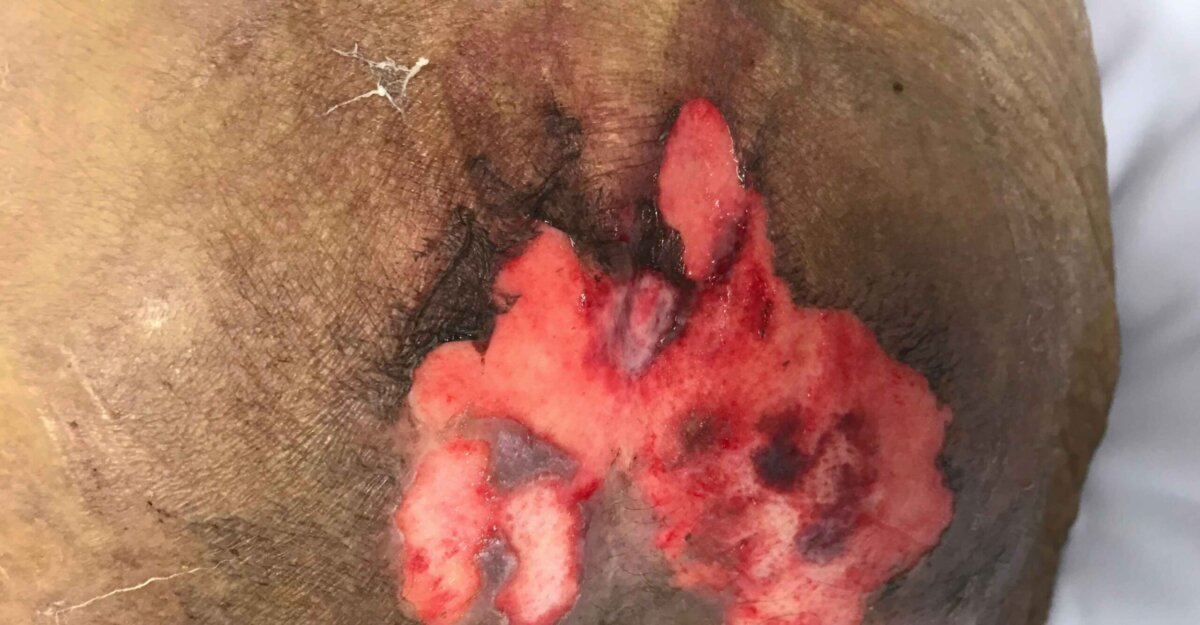Between 1 and 3 million patients are affected by pressure injuries each year. And how do these statistics involve shearing wounds and friction wounds?
Studies from the National Institutes of Health (NIH) list friction and shear as two main factors in pressure injury formation.
As wound care clinicians, we have heard and used the terms friction and shearing frequently when describing characteristics of certain wounds, especially pressure injuries or diabetic foot wounds.
The difference between these two forces may not be common knowledge. Let’s break them down and learn a little more about friction and shearing.
What is a friction wound?
Friction is a superficial injury that occurs when one surface moves over another. This typically is seen if skin is dragged across a surface. These surfaces often include bed linens, wheelchair foot pedals, or even the floor. Poor-fitting shoes may also cause friction to the point of epidermal destruction. This is often apparent when noting ongoing calluses to the feet and toes.
However, it should be noted that this can occur when patients are anxious; agitated; have spastic body movements, such as tremors and dyskinesias; or have an ill-fitting product such as tight footwear on a diabetic patient’s foot.
A friction wound can appear as skin that is excoriated, denuded, or as an area with blisters filled with serum or blood. This skin destruction is due to the epidermal layer stripping against a surface.
Ultimately, the damage to the tissue will only be limited to superficial layers thus resulting in partial thickness damage. Single movements can’t cause full thickness damage when friction is the only force involved. And friction alone can’t cause a pressure injury but can cause a traumatic wound, such as a skin tear.
What is skin shearing or a shearing wound?
A shearing wound damages the skin on a deeper level. Shearing occurs when tissue layers laterally shift in relation to each other; as when bone and deep tissue layers move in opposite directions.
Is skin shearing caused by a patient’s skin rubbing against sheets?
While shearing wounds typically occur when patients’ skin rubs against bed sheets, it may also happen when patients shift or scoot themselves across a surface instead of fully lifting their pelvis from the bed or chair. Wounds affected by shear will often have tunneling or undermining due to the deep layers of tissue destruction.
However, shearing can only contribute to and compound the damage created by pressure. (It can’t cause a pressure injury by itself.) A purely shear-based injury is a traumatic wound caused by enough inertia to keep the body moving in one direction.
How to prevent friction and skin shearing
Wounds showing evidence of friction or skin shearing should be investigated further to identify the cause. Aside from ongoing patient education, here are some prevention methods:
- Protect vulnerable areas, such as the heel, by using protective devices like soft-heel boots when at-risk patients are sitting or lying. These devices are ideal for patients with poor mobility, poor sensation, anxiety, agitation, and spasticity.
- Properly position patients by using pillows or wedges to protect at risk areas like knees, ankles, heels, and elbows.
- Reposition patients who are bedbound or often have poor.
- Keep the head of the bed at 30 degrees or below to decrease shearing forces, since the body tends to slide down when at a higher elevation.
- Keep skin healthy and less susceptible to damage by using a mild soap and warm water. Hot water and alcohol-based cleaning products or lotions will strip the skin of moisture. Overly dry skin is prone to damage.
- Provide healthy foods and drinks to patients. A balanced diet and adequate hydration play a large role in wound healing and optimal skin health.
- Control moisture. Areas prone to excess moisture include the pelvic area, between the toes, and between skin folds. These areas are at higher risk for friction and skin shearing.
- Use proper support surfaces. A good support surface like mattresses, overlays, or other devices will eliminate over-drying the skin as well as assist with the offload of bony prominences. For example, a stage 4 sacral injury patient should be on an air-fluidized bed, not a gel mattress overlay.
- Use other types of equipment to help decrease friction and shear wounds. Equipment such as mechanical lifts, trapeze bars, and lift sheets help patients and caregivers lift, move, and reposition in a way that keeps the skin from rubbing, scooting, and pulling against these surfaces.
- Check in frequently. A patient’s home needs and environments can change, and patients may not think to bring this up unless asked. Ask questions and act on these needs without delay.
Friction and shearing wounds can lead to more complications that impact patients’ quality of life, so identifying and preventing them is crucial. Remember, it’s easier to prevent than to treat it.
Editor’s Note: This content was originally published in April 2015 and has been updated with new content.
Want to learn more about skin and wound care?
Get Started →What do you think?

